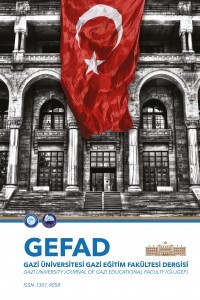ÇOK PARÇALI MEKANİK SİSTEMLERDE İVME HESAPLAMA PROBLEMLERİNDE ÖĞRENCİ GÜÇLÜKLERİ
Bu çalışma, çok parçalı mekanik sistemlerde ivme hesaplama problemlerinde öğrencilerin karşılaştıkları güçlükleri tespit etmek için yapılmıştır. Bu amaçla yazarlar tarafından geliştirilen Dinamik Soru Seti, Niğde il merkezinde altı farklı lisede öğrenim gören toplam 377 öğrenciye uygulanmıştır. DSS\'den toplanan veriler prakseolojik olarak analiz edilerek öğrencilerin ivme bulma probleminde kullandıkları teknikler ortaya çıkarılmıştır. Bulgular, öğrencilerin büyük bir çoğunluğunun cinsiyet, sınıf ve okul türü fark etmeksizin çok parçalı mekanik sistemlerde ivme hesaplama problemlerini çözerken onları hatalı çözüme götüren odak tekniği kullandıklarını göstermiştir. Araştırmada toplanan veriler odak tekniğin, özel şartlar altında ortaya çıkmış, bir grup öğrenciye özgü, özel bir teknik olmadığını göstermiştir.
Anahtar Kelimeler:
Newton'un ikinci yasası, problem çözme, prakseolojik analiz, odak teknik, fizik eğitimi.
STUDENT DIFFICILTIES ABOUT CALCULATING ACCELARATION OF MULTIPLE COMPONENT SYSTEMS
This study aims to investigate students\' difficulties related to calculating acceleration for multi-object systems. Dynamic Question Set (DQS) has been developed by authors and used as a data collection tool. DQS has been administered to 377 high school students in 6 different high schools in Nigde province. DQS solutions have been analysed according to the praxeological organization. The distributions of solution have been analysed according to variables such as gender, type of high school and class. The findings indicate that most students use an erroneous technique for calculating acceleration in multi-object mechanic systems regardless of gender, class and type of school. This technique called as focused technique is to focus on the object we ask to calculate its acceleration and to ignore the rest of the mechanical system. The findings also show that this technique doesn\'t appear under special circumstances and is not specific to a group of students.
Keywords:
Newton's second law, problem solving, praxeological analysis, focused technique, physics education.,
___
- Bolton, J., & Ross, S. (1997). Developing students’ physics problem-solving skills. Physics Education, 32, 176.
- Balcı, A. (2004). Sosyal bilimlerde araştırma yöntem, teknik ve ilkeleri. Ankara: Pegem A Yayıncılık.
- Chevallard, Y. (1992). Fundamental concepts in didactics : Perspectives provided by an anthropological approach. Recherches en Didactique des Mathématiques, 12(1), 131-1
- Chevallard, Y. (1997). Familière et problématique, la figure du professeur. Recherches en Didactique des Mathématiques, 17(3), 17-54.
- Chevallard, Y. (1999). L’analyse des pratiques enseignantes en théorie anthropologique du didactique. Recherches en Didactique des Mathématiques 19(2), 221–266.
- Chevallard, Y. (2007). Readjusting Didactics to a Changing Epistemology. European Educational Research Journal, 6(2).
- Compton, C. A. (1970). Exercises are not problems. The Physics Teacher, 8, 235–240. Çalışkan, S., Selçuk, G. S., & Erol, M. (2012). Instruction of problem solving strategies: Effects on physics achievement and self-efficacy beliefs. Journal of Baltic Science Education, 9(1) .
- Dumas-Carré, A. (1981). Les controles en question. Bulletin de l’Union des Physiciens, 632, 865-869.
- Dumas-Carré, A., & Goffard, M. (1997). Rénover les activités de résolution de problémes en physique. Paris: Armand Colin/Masson.
- ISSN: 1301-9058
- Yayın Aralığı: Yılda 3 Sayı
- Başlangıç: 1985
- Yayıncı: Gazi Üniversitesi
